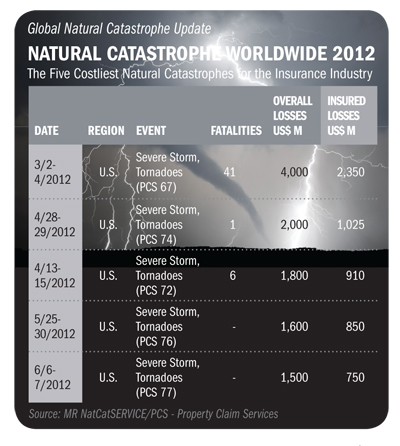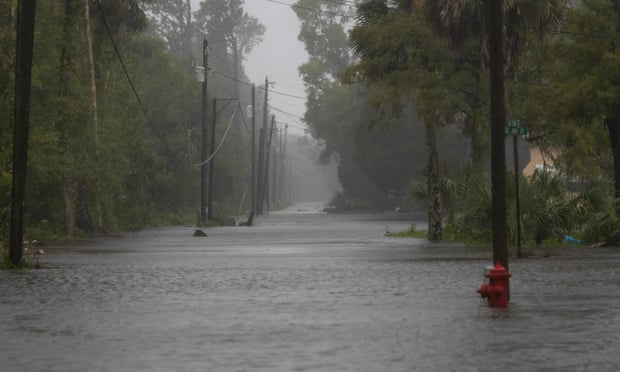 Catastrophe losses for the first half of 2012 were mild compared to the previous year and notably below the 10-year average, according to a report from Munich Re.
Catastrophe losses for the first half of 2012 were mild compared to the previous year and notably below the 10-year average, according to a report from Munich Re.
Worldwide natural catastrophe events for the first half incurred $26 billion in economic damage and $12 billion in insured losses, mostly caused by thunderstorms and other weather events in the United States.
In its annual half-year natural catastrophe review, Munich Re says that losses resulting from extreme weather from January through the end of June of this year totaled $10 billion in the U.S., representing 85 percent of worldwide insured losses and 61 percent of overall losses, about a 20-percent increase on both accounts since 1980.
Significant weather losses in the United States have so far been dominated by thunderstorm, wildfire, and tornado activity. The severe weather activity topped the list, incurring $8.8 billion of the half-year's total of $9.3 billion dollars in insured losses, a sum that still pales in comparison to the $24.4 billion seen in the first half of 2011.
The winter of 2012 claimed few losses, but low levels of spring flooding gave way to exacerbated drought during the warmest summer on record since scoring began at the turn of the last century. The U.S. drought monitor has reported record-setting conditions, said Munich Re, and wildfires have burned 1.7 million acres, mostly attributed to the Waldo Canyon fire.
This year's early tornado season produced a severe squall line that crossed several Midwestern states between March 2 and 4, slamming into 180,000 buildings and generating $2.4 billion in insured losses in the Ohio and Tennessee River Valley, as well as an outbreak in the St. Louis metro region causing 200,000 claims and $1 billion in losses.
What we haven't seen yet is the worst of the hurricane season. Unusually, two tropical storms occurred before the official June start of the 2012 Atlantic season, causing $50 million in damages. Otherwise there has been little to report on this front, says Munich Re spokesperson Thomas Reinhart, adding this could change when the season peaks in August and September.
Ernest Rauch, head of Munich Re's corporate climate center, says worldwide losses of $26 billion were spread over 450 significant loss events, the most major of which were an Eastern European cold wave claiming 745 lives; a winter avalanche in Afghanistan; Winter Storm Andrea and the earthquake in Italy.
The level was still below the six-month average of the past decade, he says. Insured losses amounted to $12 billion, compared with ten year average of $19.2 billion—and lower losses have been contributing to better profits, he adds.
“Barring any future mega-catastrophes, 2012 will eclipse 2011 profits by a significant margin, and may achieve its best levels yet in a post-crisis era,” says Robert Hartwig, president of the International Insurance Institute, attributing the surge in combined ratio in 2011 to catastrophe losses.
“In 2011, homeowner insurers suffered losses totaling $36.5 billion, but these losses evened out in the first half of this year,” says Hartwig.
Want to continue reading?
Become a Free PropertyCasualty360 Digital Reader
Your access to unlimited PropertyCasualty360 content isn’t changing.
Once you are an ALM digital member, you’ll receive:
- Breaking insurance news and analysis, on-site and via our newsletters and custom alerts
- Weekly Insurance Speak podcast featuring exclusive interviews with industry leaders
- Educational webcasts, white papers, and ebooks from industry thought leaders
- Critical converage of the employee benefits and financial advisory markets on our other ALM sites, BenefitsPRO and ThinkAdvisor
Already have an account? Sign In Now
© 2024 ALM Global, LLC, All Rights Reserved. Request academic re-use from www.copyright.com. All other uses, submit a request to [email protected]. For more information visit Asset & Logo Licensing.








